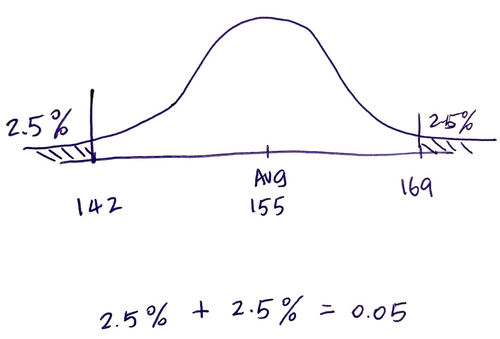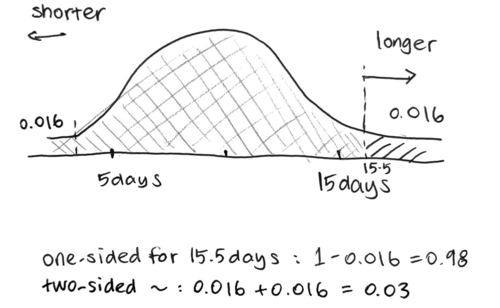Link: P-value
The basic idea
P-values are determined by adding up probabilities. It’s used to test null hypothesis e.g. the coin is a fair coin.
- The “normal” probability of this result. E.g. The chance is 0.25 for getting 2 heads if flipping a coin twice.
- The probability of getting something else that has the equal chance. E.g. getting 2 tails = 0.25.
- The probability of getting something more rare. E.g. zero in this case because getting 2 heads/tails are the lowest probability out of all outcome.
p-value = sum of above e.g. 0.5
So we fail to reject the Null hypothesis: the coin is fair. aka the coin is not special.
The intuitive behind the idea
The 2nd part of p-value: there are other things that are equally special. When theses exist, they make this event less special.
Similar logic applies to 3rd part of p-value: there are even other things that are more special, which also makes this even less special and rare.
Example: Getting 4 heads and 1 tails from flipping coins 5 times
- : getting 4 heads, 1 tails
- : getting 1 heads, 4 tails
- : getting 5 heads
p-value = 0.375. We still fail to reject the null hypothesis.
Calculate p-value for continous value
We usually use statistical distribution to calculate probabilities and p-values if it’s continous.
So, we add up the area to calculate p-value. It will tell us if the measurement comes from this distribution.
Example: Measure heights
Null hypothesis: “someone who’s 142cm could come from this distribution”.

p-value = 0.025 + 0.025 = 0.05
Inconclusive: It’s at the threshold, so it’s hard to say whether it comes from this distribution. They could come from other distribution too.
BTW, the p-value = 0.03 if the height is 141cm and we can reject the hypothesis, which suggests it may comes from other distribution.
One-sided p-value
- Decide which direction we want to see change happen.
- Only use the area that is in the desired direction (non bi-directional probability add-up)

The intuition about the difference between one-sided and two-sided p-value
Two-sided p-value would detect the unusual events happened on the both end, unlike the one-sided, which only detect one side.
Therefore, one-sided p-value is usually avoided and should be treated carefully.